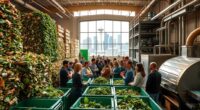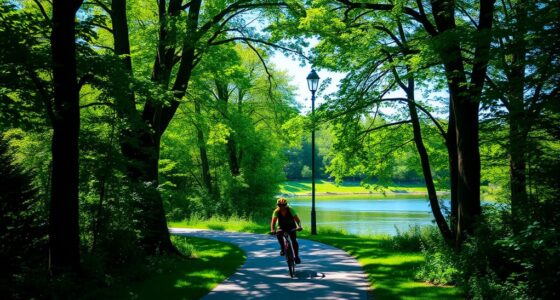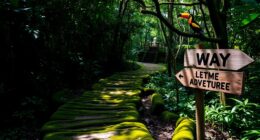When exploring Estonia’s bog landscapes, it’s essential to follow responsible practices that protect these fragile ecosystems. Stick to designated trails, avoid disturbing plants and wildlife, and use eco-friendly gear to minimize your impact. Dispose of waste properly and practice Leave-No-Trace principles. Respect local traditions and engage with communities when possible. By understanding the threats facing bogs, you can help preserve their beauty for future visitors. Continue to discover how conscious travel can make a difference.
Key Takeaways
- Stick to designated trails and follow signage to protect fragile bog ecosystems.
- Support eco-tourism and guided tours to minimize environmental impact and enhance understanding.
- Dispose of waste properly and follow Leave-No-Trace principles during exploration.
- Observe wildlife quietly with binoculars to avoid disturbing habitats and animal behaviors.
- Respect seasonal guidelines and avoid damaging vegetation to ensure bog preservation for future generations.
Understanding the Unique Ecology of Estonia’s Bogs
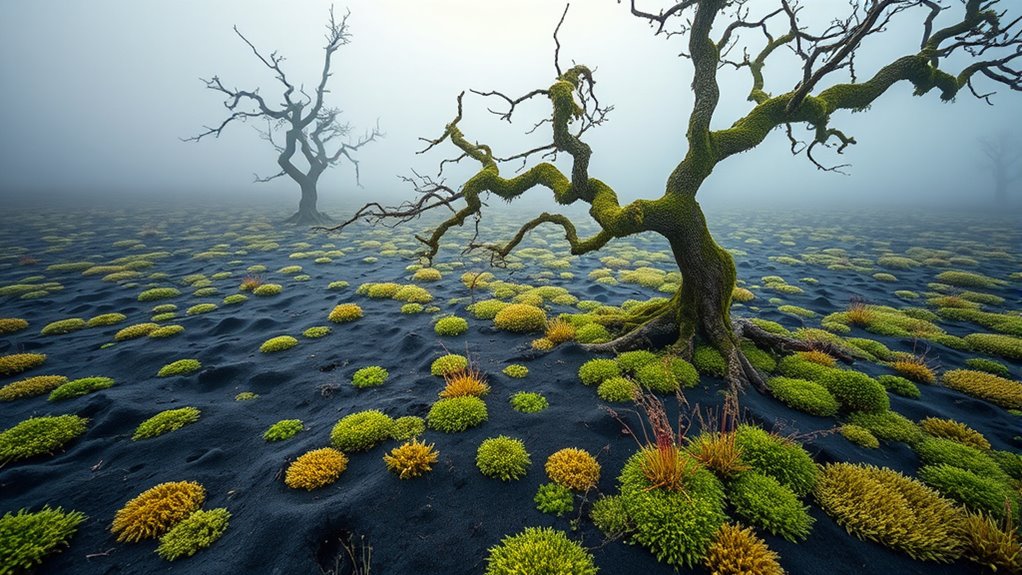
Estonia’s bogs are fascinating ecosystems that play a essential role in the region’s natural landscape. You’ll notice that bog vegetation is uniquely adapted to thrive in nutrient-poor conditions, with mosses like Sphagnum dominating the landscape. These mosses are fundamental for peat formation, as they slowly decompose and accumulate over centuries, creating thick layers of peat. This process shapes the bog’s environment, maintaining its acidic and waterlogged conditions. The specialized plants, including cotton grasses and bog pine, thrive here because they’ve evolved to survive in such challenging conditions. Understanding the delicate balance of bog vegetation and peat formation helps you appreciate how these ecosystems support a variety of specialized wildlife and contribute to global carbon storage. Additionally, the unique peat accumulation process of bogs acts as a significant carbon sink, helping to mitigate climate change impacts. The peat formation process is a slow but vital contributor to the global carbon cycle, emphasizing the importance of preserving these unique habitats. Recognizing the biodiversity within bog ecosystems highlights their ecological importance and the need for ongoing conservation efforts. Moreover, the presence of specialized plant species further underscores the uniqueness of these habitats and their role in supporting diverse flora and fauna.
Planning Your Visit: Best Times and Seasons to Explore
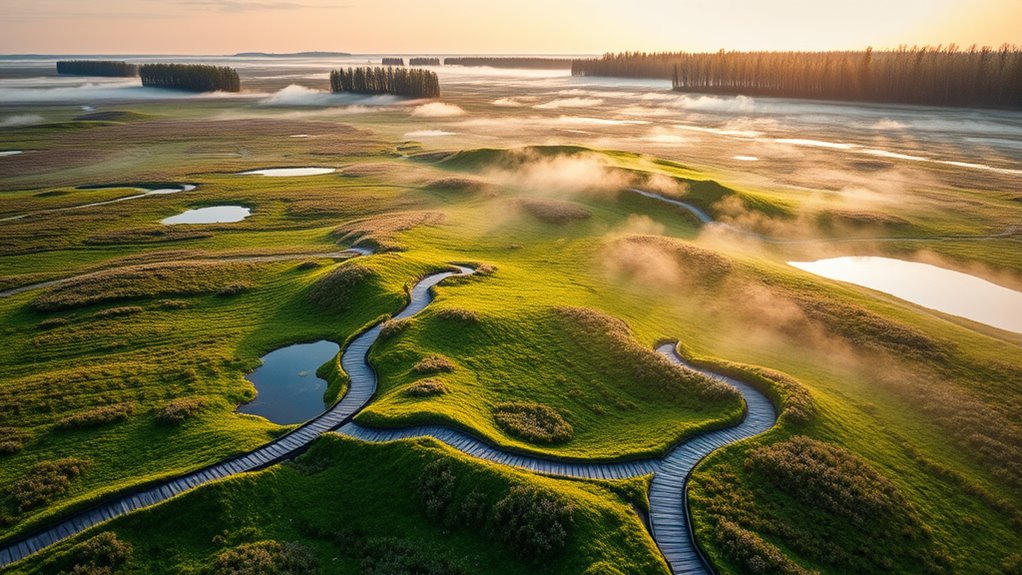
To make the most of your visit to Estonia’s mesmerizing bogs, timing is essential. The best seasons to explore are late spring and early summer when the landscape bursts with vibrant colors and migratory birds arrive, making seasonal birdwatching particularly rewarding. Summer months offer longer daylight hours, ideal for capturing stunning photography tips like using natural light to highlight the bog’s unique features. Autumn brings a quiet, reflective atmosphere, with golden foliage and fewer visitors, perfect for peaceful exploration. Winter transforms the landscape into a snow-covered wonderland, offering a rare, serene experience. Planning your trip around these seasons ensures you witness the bogs’ beauty at their peak and enjoy opportunities for birdwatching and photography that are truly unforgettable. Understanding the importance of seasonal changes can enhance your appreciation of the landscape’s dynamic beauty, especially when considering climate variations that influence the terrain and wildlife activity.
Staying on Designated Trails and Paths
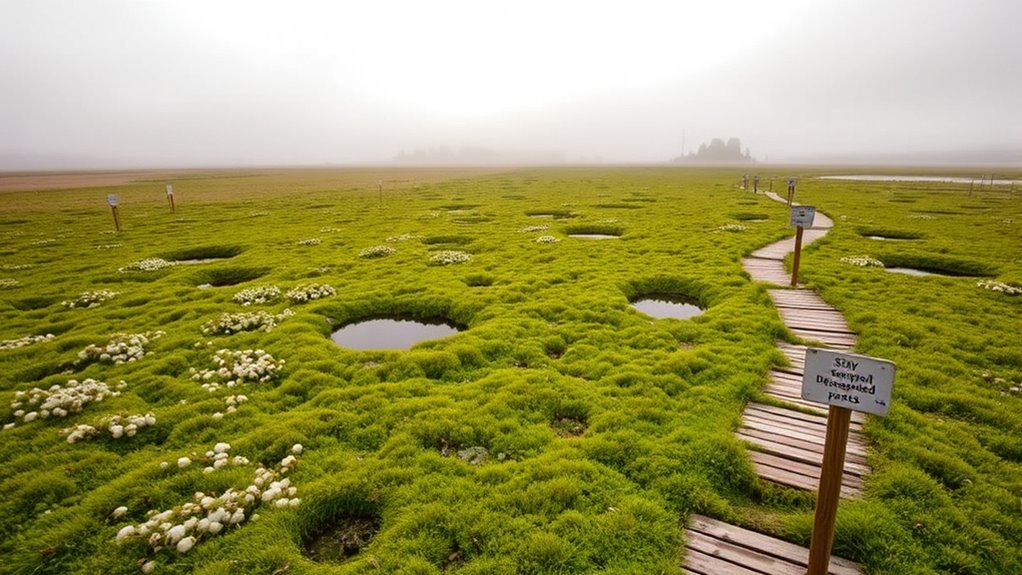
When exploring Estonia’s bogs, you need to stay on marked trails to safeguard fragile ecosystems. Following designated routes helps preserve the natural beauty and prevents damage to plants and wildlife. Always stick to the paths to ensure your visit remains sustainable and safe. Additionally, respecting site signage and guidelines is crucial for maintaining the integrity of these sensitive environments necessary cookies. To further protect the environment, using unique and wicked planters can inspire eco-friendly gardening practices that align with conservation efforts. Remember, minimizing your environmental footprint by protecting delicate habitats ensures these pristine landscapes can be enjoyed by future generations. Moreover, being aware of local regulations regarding environmental protection laws can further enhance your responsible exploration. Utilizing best airless paint sprayers for maintenance projects around natural sites can also help reduce environmental impact by providing efficient and clean application methods.
Protect Sensitive Ecosystems
Ever wonder why sticking to designated trails matters when exploring bog landscapes? Staying on marked paths helps protect fragile ecosystems from damage and disturbance. When you venture off-trail, you risk trampling rare plants and disrupting wildlife habitats. Using drone photography responsibly means avoiding areas where drones could disturb nesting birds or sensitive species. Respect camping regulations by choosing designated spots; camping outside these areas can harm the delicate ground and introduce pollution. Protecting these ecosystems ensures they stay healthy for future visitors and maintain their natural beauty. Exfoliation benefits also play a role in preserving the health of the delicate skin in these environments. Additionally, following regulatory frameworks helps organizations navigate data privacy challenges that can impact environmental monitoring efforts. Being mindful of conservation practices promotes the sustainability of these unique landscapes. Knowing how to minimize human impact is essential for maintaining biodiversity and ecosystem resilience. By following rules and staying on paths, you help preserve Estonia’s unique bog landscapes and their ecosystems, allowing everyone to enjoy them responsibly. Your mindful approach makes a real difference in conserving these precious environments, especially considering the importance of ecosystem preservation for maintaining biodiversity.
Follow Marked Routes
Staying on marked routes is essential for protecting Estonia’s delicate bog landscapes. These trails help preserve the ecological importance of the area by preventing soil erosion and damage to rare plants and wildlife. By sticking to designated paths, you also respect the cultural significance of these wetlands, which have been part of local traditions for centuries. Venturing off-trail can disturb fragile ecosystems and diminish the natural beauty that makes Estonia’s bogs unique. Clear signage and well-maintained paths are there to guide you safely while minimizing your impact. Remember, your responsible behavior guarantees these landscapes remain pristine for future visitors and continues to hold cultural and ecological value. Following the proper trail guidelines ensures you enjoy the beauty of the bogs while safeguarding their ecological integrity. Using eco-friendly travel practices can further reduce your environmental footprint during your visit. Maintaining awareness of ecosystem preservation is crucial to ensure these habitats are protected for generations to come.
Respecting Flora and Fauna During Your Exploration
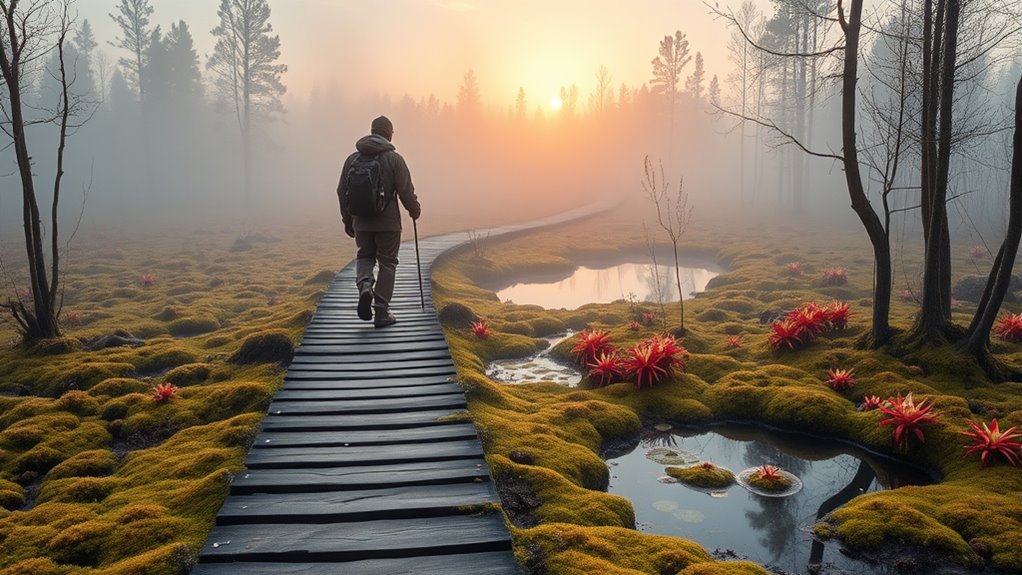
As you explore Estonia’s bogs, it’s important to stay on designated paths so you don’t disturb fragile plants. Keep your voice down and observe wildlife quietly to avoid stressing animals or birds. Respecting these natural elements helps preserve the beauty and health of the landscape for future visitors.
Stay on Designated Paths
To protect Estonia’s delicate bog ecosystems, it’s essential to stay on designated paths while exploring. Following boardwalk etiquette helps prevent damage to fragile vegetation and minimizes soil erosion. When you stick to marked trails, you support trail maintenance efforts, ensuring paths remain safe and accessible for everyone. Venturing off the paths can disturb rare plants and wildlife, and may lead to accidental trampling. Keep your footsteps within the boundaries of the boardwalk or trail, and avoid taking shortcuts or creating new routes. By respecting these guidelines, you help preserve the natural beauty of Estonia’s bog landscapes for future visitors and protect the ecosystems that depend on careful human interaction. Your responsible behavior directly contributes to the sustainability of these unique environments.
Observe Wildlife Quietly
While observing Estonia’s bog wildlife, it’s important to do so quietly and without disturbance. Your goal should be silent observation, allowing you to notice birds and other creatures without scaring them away. During bird watching, move slowly and avoid loud noises to respect their natural behavior. Keep your voice low and avoid sudden movements that could startle animals. Use binoculars if possible to minimize your presence and enhance your view. Remember, wildlife is sensitive to human activity, so maintaining a peaceful demeanor helps protect their habitat. By observing quietly, you contribute to preserving the delicate bog ecosystem and ensure your experience remains respectful and enriching. Silent observation allows you to connect more deeply with the unique flora and fauna of Estonia’s bog landscapes.
Minimizing Your Impact With Eco-Friendly Equipment
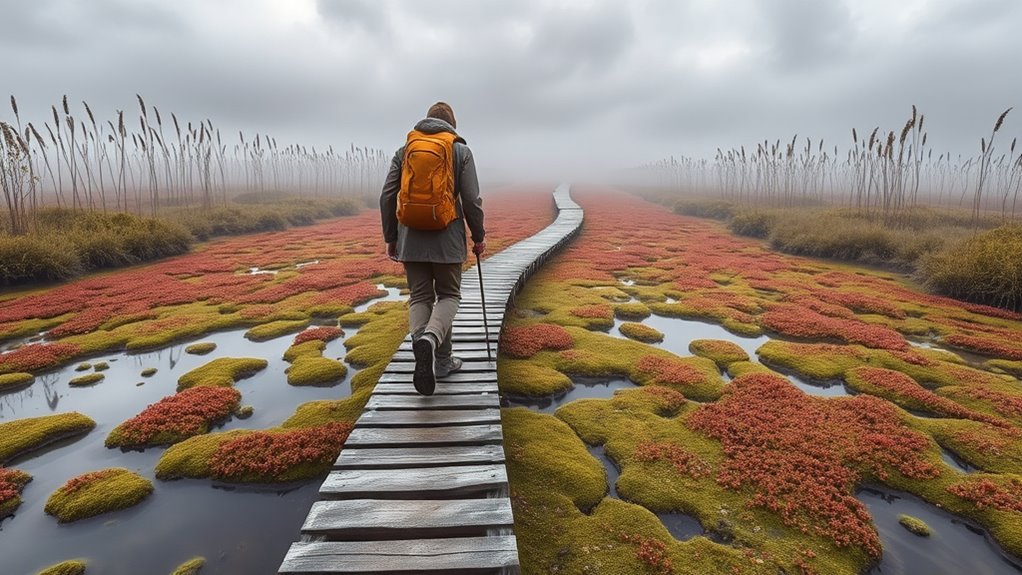
Choosing eco-friendly equipment is one of the most effective ways to reduce your impact on Estonia’s fragile bog landscapes. By selecting sustainable gear, you help protect these sensitive environments from damage caused by non-renewable resources and waste. Opt for lightweight, durable footwear designed for wet and uneven terrain to minimize soil disruption. Use biodegradable or reusable accessories, such as water bottles and packaging, to cut down on waste. Practice eco-friendly habits like carrying out all trash and avoiding unnecessary equipment. Your mindful choices promote eco friendly practices that preserve the bog’s delicate ecosystems. When you prioritize sustainable gear, you lower your carbon footprint and demonstrate respect for Estonia’s natural beauty, ensuring these landscapes remain pristine for future explorers.
Supporting Local Conservation Efforts and Guided Tours
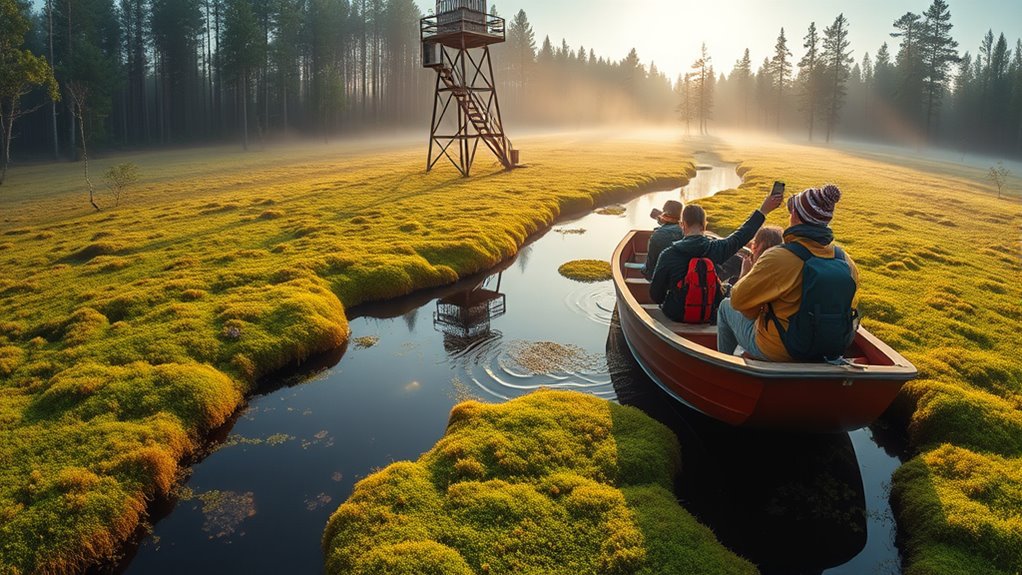
Supporting local conservation efforts and guided tours allows you to experience Estonia’s bogs responsibly. By choosing eco-tourism initiatives and partnering with local guides, you help preserve fragile ecosystems. Your involvement makes a real difference in protecting these unique landscapes for future visitors.
Promoting Eco-Tourism Initiatives
Promoting eco-tourism initiatives in Estonia’s bog landscapes plays a crucial role in supporting local conservation efforts and providing meaningful guided tours. When you participate in eco-tourism, you directly contribute to bog conservation by funding preservation projects and raising awareness about fragile ecosystems. These initiatives highlight eco tourism benefits, such as educating visitors and reducing environmental impact. To deepen your understanding, consider this table:
| Conservation Focus | Visitor Impact |
|---|---|
| Protecting biodiversity | Promoting responsible tourism |
| Maintaining ecosystems | Supporting local communities |
| Minimizing disturbance | Enhancing eco-awareness |
| Sustainable practices | Ensuring long-term preservation |
Your involvement helps sustain Estonia’s unique bog landscapes, ensuring future generations can enjoy their beauty responsibly.
Partnering With Local Guides
Partnering with local guides enhances the experience of exploring Estonia’s bog landscapes while directly benefiting conservation efforts. Local guides bring valuable knowledge about the area’s unique ecosystems, history, and cultural significance, enriching your journey. Their expertise guarantees you navigate sensitive habitats responsibly, minimizing ecological impact. Additionally, working with local guides offers personal benefits, such as authentic cultural exchange and insights into traditional practices, making your visit more meaningful. By supporting local guides, you contribute directly to the community’s sustainable development and conservation initiatives. Their deep connection to the land fosters a respectful attitude toward Estonia’s natural heritage. Engaging with local guides transforms your exploration into a responsible adventure, fostering a genuine appreciation of the landscapes while promoting ongoing preservation efforts.
Preserving Fragile Ecosystems
Engaging with local guides not only enriches your understanding of Estonia’s bog landscapes but also plays a vital role in preserving these delicate ecosystems. These guides share insights into the importance of peat moss and sphagnum layers, which form the foundation of the bog’s unique environment. By following their advice, you help minimize disturbance to sensitive areas and support conservation efforts. Your responsible behavior, like sticking to designated paths and avoiding removal of natural materials, helps protect the sphagnum layers that trap carbon and sustain biodiversity. Participating in guided tours led by experts ensures you gain knowledge while actively contributing to the preservation of Estonia’s fragile bog ecosystems for future generations. Your mindful approach makes a real difference in safeguarding these precious landscapes.
Proper Waste Disposal and Leave-No-Trace Principles
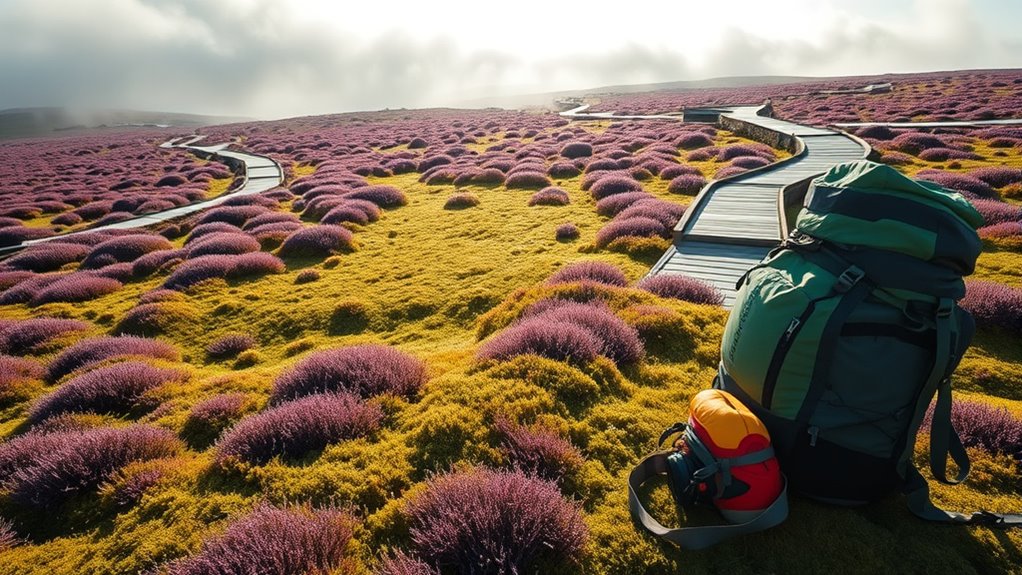
When exploring Estonia’s delicate bog landscapes, it’s essential to practice proper waste disposal and follow Leave-No-Trace principles. You should pack out all trash, including food wrappers and bottles, to prevent harming the fragile environment. Keep to established paths to minimize soil disturbance and avoid creating new trails. Always dispose of waste in designated bins or take it with you. Remember, adhering to Leave-No-Trace principles guarantees these unique ecosystems remain pristine for future visitors.
- Pack out all trash and litter
- Stay on marked trails to protect vegetation
- Avoid disturbing wildlife or plants
- Minimize campfire impact by using existing fire rings or avoiding fires altogether
Engaging With Local Communities and Respecting Traditions
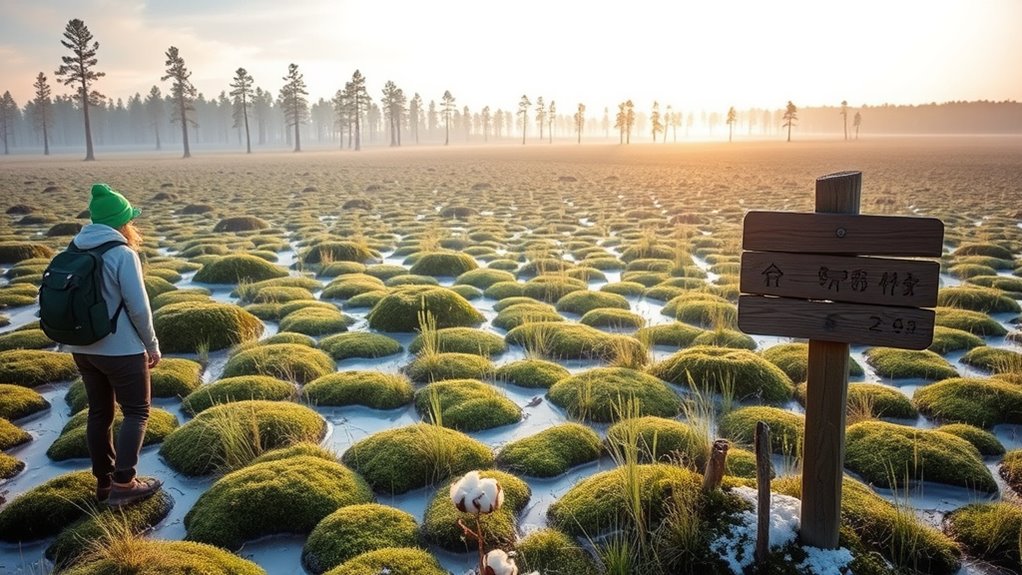
Respecting local communities and their traditions is essential when exploring Estonia’s landscapes. You should prioritize local community engagement by speaking with residents, learning about their customs, and supporting local businesses. Respect cultural traditions by following community guidelines and participating respectfully in local activities. Avoid disrupting daily life or desecrating sacred sites. When visiting bog areas, seek permission if necessary and stay on designated paths to protect both the environment and cultural heritage. By showing genuine respect and interest, you foster positive relationships and gain deeper insight into the region’s history and customs. Remember, responsible tourism involves listening, learning, and acting thoughtfully, ensuring that your presence benefits both the community and the preservation of Estonia’s unique landscape.
Educating Yourself About Bog Preservation Challenges
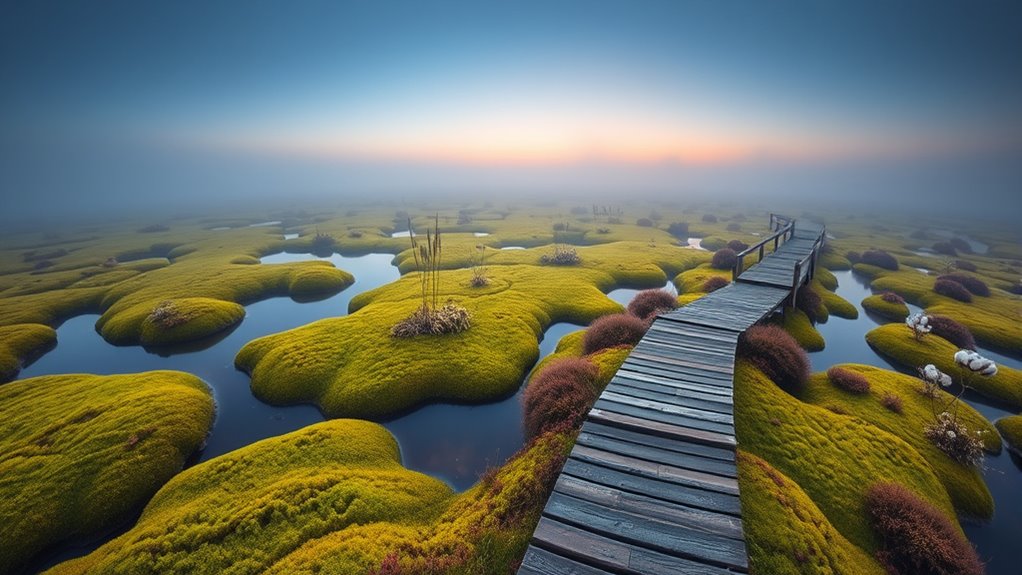
Understanding the challenges faced by bog ecosystems is essential for responsible exploration. Bog peatlands are delicate environments impacted by various conservation challenges, from drainage to climate change. To protect these unique landscapes, it’s vital to educate yourself about the issues they face.
You should learn how human activities, like peat extraction and land development, threaten bog ecosystems. Recognizing the importance of natural water regulation and carbon storage helps you appreciate their value.
Key conservation challenges include:
- Draining bog peatlands for agriculture or development
- Peat extraction disrupting natural habitats
- Climate change accelerating peatland degradation
- Encroachment from tourism and infrastructure
Spreading Awareness and Inspiring Responsible Tourism

Have you ever thought about how your actions can help protect Estonia’s precious bog landscapes? Spreading awareness is key to inspiring responsible tourism. By sharing knowledge about bog peatlands and their moss diversity, you help others appreciate their fragile beauty. You can encourage fellow travelers to stay on designated paths, avoid disturbing plant life, and leave no trace. Educating others about the importance of moss diversity and bog ecosystems fosters respect and conservation efforts. Here’s a quick guide:
| Do’s | Don’ts |
|---|---|
| Respect designated trails | Pick wild plants or mosses |
| Leave no trace | Litter or disturb habitats |
| Share knowledge | Damage fragile moss layers |
| Support eco-friendly tours | Ignore conservation signs |
Together, your responsible actions can ensure these landscapes thrive for generations.
Frequently Asked Questions
How Can I Identify Endangered Species in Estonia’S Bogs?
To identify endangered species in Estonia’s bogs, you need to focus on wildlife monitoring and plant identification. Keep an eye out for rare plants and animals listed on conservation lists, and use field guides to help recognize distinctive features. Joining local conservation groups or expert-led tours can also provide valuable insights. By actively observing and recording your findings, you contribute to protecting these fragile ecosystems and their endangered species.
Are There Any Specific Safety Precautions for Exploring Bogs?
Did you know that bog safety is vital, as accidents happen more often than you’d think? When exploring bogs, always stick to designated paths and wear waterproof boots to prevent slips. Visitor precautions include avoiding thick moss patches and not venturing into unknown areas. Stay alert, carry a map, and inform someone of your plans. These precautions guarantee your adventure remains safe and enjoyable while respecting the delicate bog environment.
Can I Collect Plants or Other Natural Items During My Visit?
When visiting bogs, you might wonder about plant harvesting or natural item collection. It’s best to avoid taking plants or other natural items, as doing so can harm the fragile ecosystem. Always respect local regulations, and if collection is permitted, do so sparingly and responsibly. Remember, preserving these unique landscapes guarantees everyone can enjoy their beauty and ecological importance for years to come.
What Are the Signs of Ecological Imbalance in Bog Areas?
You might notice that bog vegetation starts to thin out or die back, signaling ecological imbalance. Water quality may decline, turning dark or murky instead of clear, hinting at pollution or nutrient overload. Damaged moss layers or exposed peat can also indicate trouble. These signs warn you to step back, as consequently, these changes threaten the delicate balance of the bog ecosystem, which you should protect by observing without disturbing.
How Can I Contribute to Local Conservation Initiatives Beyond Tourism?
You can support local conservation initiatives by actively engaging in community involvement and promoting sustainable practices. Volunteer with local groups, participate in restoration projects, or spread awareness about bog ecology. Don’t just visit; contribute by respecting protected areas, reducing your environmental footprint, and encouraging others to follow sustainable practices. Your efforts help preserve Estonia’s unique landscapes, ensuring they remain healthy and vibrant for future generations.
Conclusion
As you wander through Estonia’s misty bogs, remember that your footprints can either harm this fragile paradise or help preserve its beauty. By respecting the delicate flora and fauna, you become part of an essential story—one of balance and hope. Let your responsible exploration be the light that guides others, turning a simple visit into a lasting legacy. In these quiet wetlands, your mindful footsteps can echo as a call to protect and cherish nature’s hidden treasures.


